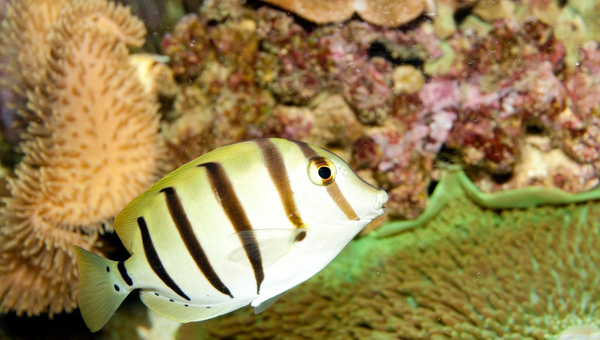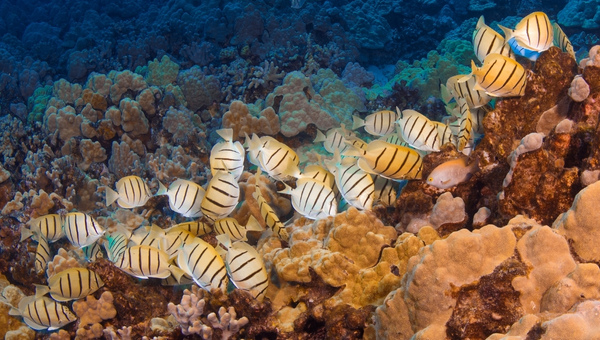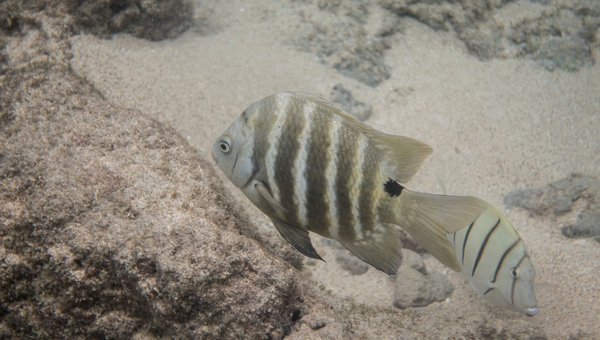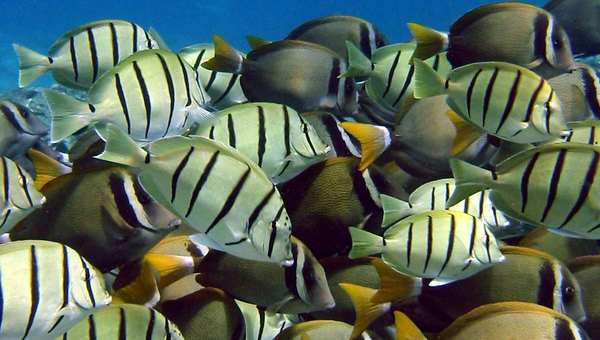Let’s discuss all of Convict Tang. The Convict Tang or Acanthurus convictions is a small surgeonfish in the Indo-Pacific region.
It is a popular aquarium fish and is one of the most common surgeonfish in the trade. It is a saltwater fish and is very popular. They give a lot of opportunities to start a reef environment.
Convict Tangs will be a great addition to your marine setup, whether you want corals. They usually remain calm but sometimes show aggression towards similar species. The Convict Tang makes your aquarium attractive and active. This is the perfect guide if you plan on getting some Convict Tangs.
We will cover everything you need to know about Convict Tangs, from their habitat and diet to their behavior and tank mates. We hope that this article helps you, so please keep on reading!
Species Specifications
Table of Contents
- Species Specifications
- Convict Tang Care Guide
- Convict Tang Diet In The wild
- Convict Tang Diet And Nutrition In Captivity
- Feeding Frequency
- Different Feeding Methods
- Maintaining A Healthy Diet
- Tank Parameters
- Water Parameters
- Water Changes
- Cleaning The Tank
- Water Conditioners
- Lighting And Heating Requirements
- Filtration Requirements
- Substrate And Gravel
- Plants And Tank Decorations
- Coral And Convict Tangs
- Ammonia And Nitrates Level
- Protein Skimmer And Gravel Vacuum
- Water Test Kits
- Tank Setup
- Transportation And Handling
- Convict Tang Tank Mates
- Symptoms Of Poor Water Quality
- Convict Tang Potential Diseases
- Convict Tang Treatments And Medications
- Convict Tang Frequent Mistakes To Avoid
- Advantages Of Having Convict Tang In Your Tank
- Disadvantages Of Having Convict Tang In Your Tank
- Wrapping It Up
| Scientific name: | Acanthurus Triostegus |
| Care Level: | Intermediate |
| Origin: | Indo-Pacific region |
| Temperament: | Semi-aggressive |
| Color Form: | Black and white stripes |
| Lifespan: | 5-7 years |
| Size: | 5-8 inches(in some case 10-11 inches) |
| Diet: | Omnivore |
| Family: | Acanthuridae |
| Minimum Tank Size: | 75 gallons |
| Tank Setup: | Saltwater- fish only or reef environment |
| Water Temperature: | 72°-80°F |
| Compatibility: | Peaceful community |
These fish are magnificent and are very fun to look at.
They will be a great source of entertainment for you and are best suited for any marine setup. By now, we believe you know why they are so popular. But now the question is where you can get them and how? You can get them from your local fish store or online. They are straightforward to find. You can get them for as low as $30.
Now the question arises how do you choose a healthy fish? A healthy Convict Tang should have the following:
- A rounded body
- Clear eyes
- Nostrils that are not swollen
- Fins that are not ripped or shredded
- Gills that are a deep red color
- Scales that are not raised
It would be best if you were very careful while choosing your Convict Tang. Ensure you get your pet fish from a reputed supplier or pet store. This will ensure that you get good-quality fish and are not fooled by people. This will also save you and other aquarium members from any mishap.
Also, check Tomini Tang Fish Care Guide: Appearance, Breeding & All
Convict Tang Appearance
These beautiful creatures are also known as Convict Tang or surgeonfish. The name comes from their unique coloration. They have black and white stripes on their bodies, resembling the prisoners’ clothes. This is why they are called Convict Tangs.
The stripes are spaced regularly from their head to their caudal fin. They are very beautiful fish and will look great in any aquarium. The dorsal fin extends the whole body length but is short and does not grow far from the body.

The dorsal fin has yellow hues. Their eyes are at the front of their bodies and are protected by a thick bony plate. The eyes are large and have a yellowish color. Their mouth is located at the bottom of their head and is small in size.
They have small teeth that are used for grazing on algae. The pectoral and pelvic fins are long and thin. The anal fin is long and has a yellow hue. The caudal fin is forked and also has a yellow hue. The tail is used for balance and steering.
The Convict Tang has a laterally compressed body that is oval. They have dark stripes that extend from their mouth to the base of their tail. These dark stripes set them apart from other fish in the genus Acanthurus.
Convict Tang Origin And Distribution
The Convict Tang is found in the Indo-Pacific, east pacific regions, Mediterranean, Hawaii, and the Adriatic Sea. They are found in Indonesia, the Philippines, New Guinea, and Australia. They are now famous worldwide and found in countries like the United States, Canada, and Europe. They reached these countries by way of trading.
Convict Tang Habitat And Natural Environment
The Convict Tang is a reef-dwelling fish found in the reef wall or on the reef’s outer edge. They are also found in coral reefs and lagoons.
They live on shallow coral reefs no deeper than 300 feet, surrounded by many other species. They are primarily found in sheltered areas with plenty of algae to eat. These areas are warm and alkaline.

Corals compose most of the material, but weeds and algae would be major diet components. There would also be plenty of light and water movements.
They are also found in seagrass beds and rocky areas. The Convict Tang is a peaceful fish and is mainly found in groups.
Check Otocinclus Catfish Care Guide: Appearance, Lifespan, Food & Diet, Breeding & All
Convict Tang Size And Lifespan
The average adult size of the Convict Tang is about 5-6 inches. They can grow up to a maximum size of 11 inches. You need a big tank to accommodate them as they are big fish.
The life expectancy of the Convict Tang is about 20 to 30 years in captivity which is very long, but you will be shocked to know that they can live longer than this in the wild.
Behavior And Temperament
The Convict Tang is a peaceful fish, but it can be aggressive toward other fish if they feel threatened. They are also known to pick at corals and anemones. If you keep them with smaller fish, they may eat them.
They are also incompatible with other tangs as they will fight with them. They will occupy all tank levels, mainly for the search for algae. They are naturally shoaling fish, but this is less common in an aquarium as it can lead to problems with aggression unless the tank is large enough.
The female Convict Tangs are more significant than the male Convict Tangs. The male Convict Tangs have smaller bodies and shorter tails. They also have brighter coloration than the female Convict Tangs. Another way to be sure is to look for a dark stripe that runs along the length of the body. This is more pronounced in males.
Also, check Goldfish Tank Mates List ( ): Friends & Enemies
Convict Tang Reproduction And Breeding
Breeding is challenging and is not recommended for the home aquarium. Breeding requires a huge tank which is not readily available in homes.
Even if you manage to have that big tank, it is challenging to make them spawn and make things even more difficult; the young ones are complicated to rear. If you want a breeding tank, this is not a suitable species.

The reproduction of this fish happens when the female lays her eggs on the coral reef. The male then fertilizes the eggs, hatching them within a few days. The young fry is tiny and must be fed minimal food items. They also need many hiding places or other fish to eat them.
Convict Tang Care Guide
Here, we will share all about the care for Convict Tang through their diet, tank size, etc.
Convict Tang Diet In The wild
The Convict Tang is an omnivore whose diet consists of plant and animal matter. In the wild, they mostly eat algae but also consume small invertebrates. They use their small teeth for grazing on algae. They are also known to pick at coral polyps. Finding food in the wild is not a problem because they have plenty of algae to eat.
Convict Tang Diet And Nutrition In Captivity
You should give your Convict Tang a diet rich in plant matter. You can provide them with algae sheets, spirulina, and marine seaweed. You should also give them high-quality frozen foods and pellets rich in plant matter. You can also give them live foods like brine shrimp and Mysis shrimp.
Feeding various foods to get all the Nutr would be besties they need.
Feeding Frequency
Feeding your Convict Tang 2 to 3 times daily would be best. They are not big eaters, so you don’t need to worry about overfeeding them. They are also not fussy and will accept dried food, like flakes and pellets, and frozen foods that are more nutritious.
You can train them to have certain foods, but you need to ensure that they eat what you give them because if they get hungry, they will start eating your corals.
Different Feeding Methods
There are many different ways that you can feed your Convict Tang. You can use a feeding ring, a small plastic ring where you put the food, and they have to eat it there. This is an excellent way to control their eating habits. You can also use a turkey baster to squirt the food into the water so they can eat it.
Maintaining A Healthy Diet
A healthy diet is essential for Convict Tang. If they don’t have a balanced diet, they can develop nutritional deficiencies, harming their health. One of the most common deficiencies is vitamin C, which can cause problems with the immune system and make them more susceptible to diseases.
Vitamin C deficiency can also cause problems with their eyesight and cause them to develop cataracts. To prevent vitamin C deficiency, you should give your Convict Tang a diet rich in vitamin C. You can give them foods like kale, broccoli, and spinach.
You can also give them supplements that contain vitamin C.
Check Sand Sifting Starfish 101: Care, Appearance, Lifespan, Diet & All
Tank Parameters
The minimum tank size for the Convict Tang is 75 gallons. They need a lot of space to swim and plenty of hiding places. If you have a smaller tank, they will become stressed, leading to health problems.
Keeping multiple Convict Tangs will require a bigger tank with at least 100 gallons and much hiding space. The larger the tank, the less aggressive they will be as they will get their territory to claim.
Water Parameters
The Convict Tang is a saltwater fish that needs water with a salinity of at least 30ppt. The pH of the water should be between 8.1 and 8.4, and the temperature should be between 72° to 80°F.
Specific gravity needs to be between 1.023 and 1.025. You should replicate these parameters to keep your fish healthy.
Water Changes
You should do a water change of at least 10% every two weeks. This will help remove toxins and replenish the water with fresh and clean water. You should not wipe the algae as Convict Tangs need this as their food. You should indulge in cleaning it only if the algae is out of hand.
Cleaning The Tank
These fish produce a lot of waste, and the smaller your tank is, the more messy and dirty it is going t look. A bigger tank will reduce this problem. Although they eat the algae and try to keep your tank clean, you are responsible for keeping it tidy.
You should clean the tank once in a while to control algae growth and remove any debris from the tank.
Water Conditioners
You should use a water conditioner to remove toxins from your tap water. This is very important as it will help keep your fish healthy and prevent any disease outbreak in your tank. Many different water conditioners are available on the market, and you should choose one suitable for your fish.
Also, check Rainbow Shark Best Care Guide: Facts, Characteristics & All
Lighting And Heating Requirements
The Convict Tang needs a lot of light and a well-lit tank. They also need a tank with many hiding places as they are timid fish. The lighting should be between 10 and 12 hours per day. The temperature should be between 72° to 80°F.
You can use a heating element to maintain the temperature of your tank. Standard aquarium lighting will be fine for this fish.
Filtration Requirements
The Convict Tang needs a sound filtration system as they produce a lot of waste. The filter should handle at least ten times the water in your tank. You can use a canister filter or a power filter for your fish. The important thing is that the filter can remove all the debris and waste from your fish.
Substrate And Gravel
The Convict Tang needs a substrate that is not too rough as they have a delicate mouth. Smooth gravel or sand is perfect for this fish. They also need a lot of hiding places, and you can use rocks and caves to provide these for your fish.
Plants And Tank Decorations
The Convict Tang is a shy fish, and they need a lot of hiding places. You can use rocks and caves to provide these for your fish. Ensure the rocks and caves are secure and do not fall on your fish. You can also use live plants to provide hiding places for your fish.
The plants will also help keep the water clean and free from toxins. You can also use fake plants but ensure they are not harmful to your fish.
Coral And Convict Tangs
The Convict Tang will not generally destroy your coral, and it will not harm it. They will also help keep your coral clean by eating the algae that grow on it. You can keep Convict Tangs with most types of coral.
But they sometimes tend to nibble when hungry and do not get a proper diet. They might hurt your corals if there are no algae in the tank. They especially like stony corals.
Also, check Red Devil Cichlid 101: Best Detailed Care Guide
Ammonia And Nitrates Level
You should regularly check the ammonia and nitrate levels in your tank. The ammonia and nitrate levels should be 0. The nitrate level can be slightly higher but should not exceed 20 ppm. If the ammonia or nitrate levels are high, you should change the water to remove these toxins from your tank.
Protein Skimmer And Gravel Vacuum
A protein skimmer is a machine that removes waste and debris from your fish. It has a chamber where the waste is collected, and you can remove it from your tank. A gravel vacuum is a machine that sucks up the debris from your gravel and cleans it.
You should use a protein skimmer to remove any toxins from your water. This is very important as it will help keep your fish healthy and prevent any disease outbreak in your tank. You should also vacuum the gravel to remove debris and waste from your fish.
Water Test Kits
You should test the water in your tank regularly. This is very important as it will help keep the water clean and toxins-free. Many different water test kits are available on the market, and you should choose one suitable for your fish.
Tank Setup
The Convict Tang needs a lot of hiding places and plenty of swimming space. They also need a lot of live rock for grazing. The tank should have a sand bed for them to sift through. You can also add some coral skeletons for them to pick at. The lighting should be moderate, and the tank should have a cover to prevent the fish from jumping out.
Check Red Empress Cichlid 101: Best Care Guide
Transportation And Handling
When you are transporting your fish, you should use a plastic bag. Fill the bag with water from the tank and add some air. Seal the bag in a cooler to keep the fish cool during transport. You should be very careful when handling your fish as they can be easily injured. If you want to move them from one tank to another, you should use a net.
A net is a piece of cloth or plastic with many small holes. The net is used to catch fish and other small animals. You can place the net over the fish and lift them out of the water. You should not drop the fish on the ground as this can harm them.
Convict Tang Tank Mates
The Convict Tang is a peaceful fish, but it can be aggressive toward other fish if they feel threatened. They are compatible with most fish, but you should avoid keeping them with smaller fish as they may eat them.

The best tank mates for the Convict Tang are other peaceful fish such as clownfish, green Chromis, blennies, cardinalfish, and Royal gramma. The problem comes when they are kept with fish resembling them, such as butterflyfish and angelfish.
Symptoms Of Poor Water Quality
The Convict Tang is a very hardy fish but is still susceptible to poor water quality. Poor water quality can cause several health problems in fish, such as infections, diseases, and death. The best way to prevent these problems is to maintain a high level of water quality in your tank.
Poor water quality symptoms include lethargy, listlessness, eating refusal, and increased breathing. If you notice any of these symptoms in your fish, you should check the water quality immediately and take steps to improve it.
Check Plakat Betta Best Care Guide, Facts & Species Summary
Convict Tang Potential Diseases
The Convict Tang is a very hardy fish, and they are not susceptible to many diseases. However, they can sometimes develop problems with their eyesight, and they can also develop nutritional deficiencies. If you suspect your fish is sick, you should take them to the vet for a check-up.
Some other diseases that can affect your fish are:
- Cataracts: This condition causes the eye’s lenses to become opaque, leading to blindness.
- Hole in the Head: In this condition, small holes form. It is usually caused by poor water quality or a lack of nutrition.
- Nutritional Deficiencies: This can be caused by a lack of algae in the diet. It can also be caused by a lack of vitamin C in the diet.
Convict Tang Treatments And Medications
The best way to prevent diseases in fish is to maintain a high water quality level and provide them with a healthy diet. If your fish become sick, you should take them to the vet for a check-up.
Some common treatments and medications include:
- Antibiotics: These are used to treat infections.
- Fungicides: These are used to treat fungal infections.
- Anti-parasitic medications: These are used to treat parasites.
- Vitamins: These are used to treat vitamin deficiencies.
Convict Tang Frequent Mistakes To Avoid
One of the people’s most common mistakes when keeping Convict Tangs is not providing enough space. These fish need much room to swim and plenty of hiding places. They will become stressed if you do not provide enough space, leading to several health problems.
Another mistake that people make is not providing them with enough food. These fish need to eat a lot of algae and will become malnourished if you do not provide enough food.
Another mistake is that people don’t quarantine their fish before adding them to the main tank.
This is important because it allows you to check for diseases and parasites. If you do not quarantine your fish, they could introduce these diseases and parasites into the main tank, which could cause many problems.
Also, check Butterfly Betta Care Guide: Appearance, food & Diet, Breeding & All.
Advantages Of Having Convict Tang In Your Tank
The Convict Tang is a trendy fish because they are hardy and beautiful. They are one-of-a-kind fish. They are also an excellent addition to a peaceful community tank. These fish are also known to be very good at controlling algae growth. They are easy to maintain.
Disadvantages Of Having Convict Tang In Your Tank
The main disadvantage of having a Convict Tang in your tank is that it can be aggressive. They will often fight with other fish, which can cause many problems. They also need a lot of space and will become stressed if you do not provide enough space.
Another disadvantage of these fish is that they are very messy eaters and often mess up the tank.
Wrapping It Up
The Convict Tang is a very hardy fish, and they are easy to care for. They are also very peaceful and will get along with most other fish. They are not aggressive towards other fish and will not bother them. They might only become aggressive if they feel threatened or are not getting enough food.
We hope this article has been helpful and you have learned everything you need about the Convict Tang. We tried to deliver you with all the information possible. We hope you at least learned the basics about these fish and how you can care for this fish. Thank you so much for reading this article, and best of luck!



